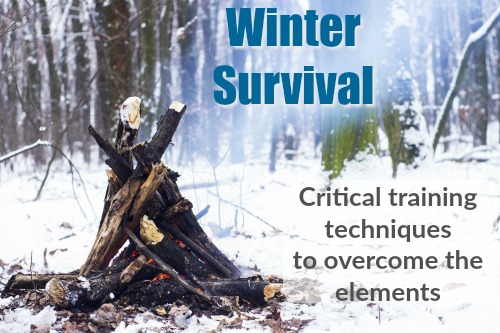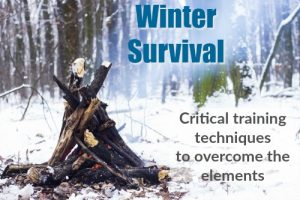
Essential Winter Gear
- Proper and effective dress: We have covered the importance of layering in previous articles [2]. Everyone has their preferences; however, a good set of polypro thermals [3] that wick off moisture and a good set of Gore-Tex upper and lower garments are a start.
- Backpack: I prefer the large Alice pack [4] of the Army; however, what you need is to be comfortable with your gear, and for your gear to work. You need food, a source of heat, fire making equipment, a blanket/sleeping bag, a water supply that will not readily be frozen, extra clothing as needed, and the likes. For a sleeping bag, I prefer the insulated issue bag with a Gore-Tex cover. Don’t forget a ground pad of some type.
- Tools: A hatchet [5] (preferably one with a hammer-head and a hatchet blade with one continuous piece incorporated into the handle; a good hunting knife [6], and a good utility knife (Swiss Army knife, or a multipurpose tool [7] will fit the bill).
- Sheltering equipment: I prefer the Army issue poncho [8] (that has grommets) and five (5) bungee cords [9] for the four corners and the top (hood portion tied off) for an expedient shelter. You can take a pup or dome tent, but be sure of how to put it up before you go out in the woods.
- Must-haves: these are things on your person when you venture forth – lighter, compass [10], thermometer (or device to compute temperature, such as wrist thermometer, etc.), flashlight, map of area for exercise. Use your judgement as to what other things you need.
Critical Tasks for Training in Winter
Let’s identify some critical tasks that you need to be able to perform in the wintertime. These tasks pertain also to requirements you need to fulfill to be able to operate in the outdoors.
- For the first one, plan on just doing an “overnighter” or such, if you’ve never been outside overnight in a winter environment. As with physical exercise: train, don’t strain [11]. Same principle here. You want to see how well your skills work and what you need to improve upon. It’s also a good way to test your equipment and yourself. You are trying to learn by experience and not hurt yourself, so don’t push it beyond your limits this first time.
- For your water-carrying containers: use whatever you have that is insulated to a high degree, and if it is going to freeze? You should leave about ¼ unfilled to keep your container from splitting. Then, what do you do with it? For wintertime, I have “special” one quart canteens, the older issue ones made from metal, with a screw on cap lined with cork. The canteen carrier helps to insulate the canteens, but if they freeze…plop one on top of a small folding stove or at the edge of a fire and it’ll thaw that water out in no time. In addition, the canteen nests in the canteen cup and you can thaw snow or ice to make water for yourself.
- Bivouac in an area that is close to home. In an emergency, you can get home readily. Now you can practice with that “safety net” if you need it. Practice everything: making fires in the snow, making lean-to’s and igloos, and tree-pit shelters. Practice your navigation with a compass. This is where the military issue compass comes in handy, as it’s not liquid filled and not subject to freezing. You should write down your experiences in some kind of a logbook or journal to use for improving later.
- Practice tracking your non-hibernating animals. Learn the difference between a dog’s track in the morning, and in the afternoon when the sun melts the edges of the impression and expands the track, making it look bigger. You’ve brought the ground covering mat and the poncho with you. Alright. Now, knowing you have that in reserve, practice clearing snow away from a patch of ground and using fallen pine boughs as ground cover. Fashion a lean-to for yourself from the surrounding fallen timber.
- At night, practice building your fire and building a fire-reflecting wall [12]. Take constant notes on the things you observe: what you see, hear, feel, and smell. Practice land navigation [13] and orienteering in the daytime, and (until you’re comfortable) for short distances at night. Learn to use the stars [14] if they’re visible, as mentioned in previous articles. If the S ever HTF, you’ll be way ahead of the power curve regarding living in the field and the boonies in a winter environment.
Mind you, these are all basics for you to try. These basics will help you to inspire confidence in yourself and your skills. Winter weather and a cold environment with snow and ice on the ground presents challenges, but they can be overcome and mastered with practice. Stay warm, be safe, and keep up the good work! JJ out!
